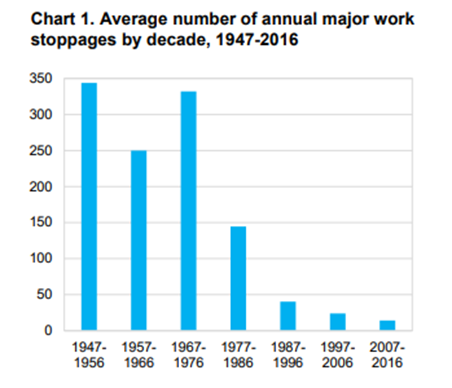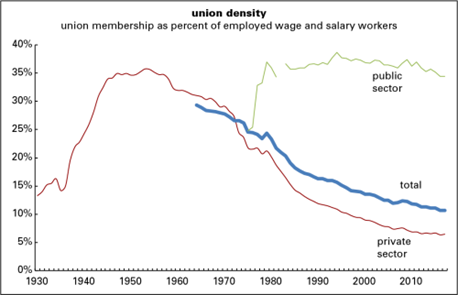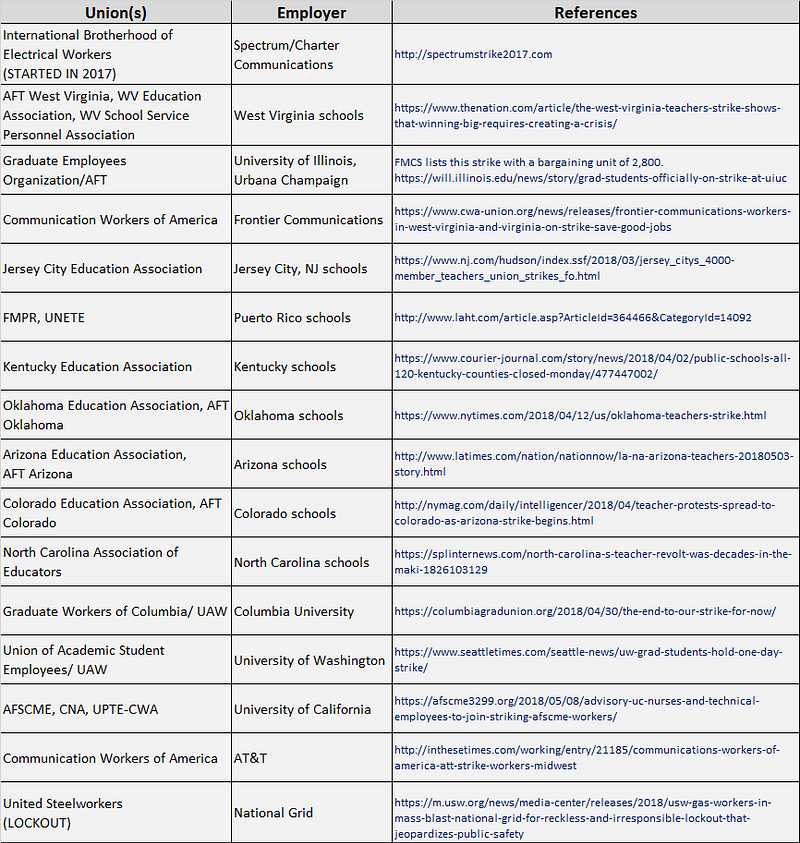Richard Mellor
Afscme Local 444, retired
This is an interesting article about the increase in strike activity over the past period but the author leaves out a crucial detail that has to be present in any commentary on this subject and that is the trade union hierarchy, the leadership of organized labor as a whole.
Afscme Local 444, retired
This is an interesting article about the increase in strike activity over the past period but the author leaves out a crucial detail that has to be present in any commentary on this subject and that is the trade union hierarchy, the leadership of organized labor as a whole.
Firstly the heads of organized labor did nothing but utter a few platitudes when Reagan smashed the PATCO strike and banned 11,000 workers from that industry for life. This gave Reagan and the bosses' the green light and they went on a serious assault against organized labor. In the wake of PATCO and through the 1980's though there were numerous attempts in some major disputes to drive back this capitalist offensive and it is important to recognize this. I remember seeing physical battles between cops and Teamsters during the Newspaper strike, I think it was in Detroit. Two Greyhound strikes, the year long UFCW P9 strike at Hormel in Austen Minnesota, the Eastern Airlines and Staley strikes and others. These battles ended in defeat primarily though a powerful combination of the bosses' and the heads of organized labor;
In the strike in my own workplace in 1985 we tried to push the wider trade union movement to act and to draw in the community but we did not have sufficient resources to do this and this too, why the rank and file is not stepping up, is due to the role of the leadership at the highest levels. The 1980's was an opportunity missed but as usual, the trade union hierarchy ensured capital got its way. The alternative is too frightening for the labor bureaucracy, to mobilize their members in a major assault on capital, even as a defensive measure. They have no alternative to capitalism, to mobilize the potential power of organized labor which would draw in all sections of the working class can only lead to chaos from their pro-market perspective.
I am grateful to the author for pointing to the increase in the class struggle among the organized working class and he points to the recent West Virginia strike and the uprising of teachers in states where striking is illegal and with Republican governors. But again, it is important to point out the situation of the trade union leadership which has in the past 40 years suppressed any serious threats to their leadership from emerging with the ranks as it would threaten this relationship they have built with the bosses based on labor peace.
These recent educators movements (all workers in education were drawn in to it) occurred not only in opposition to state law, but against the official trade union leadership. It is the weakness of the trade union bureaucracy or that it was not present at all that was a plus. In other words the official pro-management leadership of organized labor was too weak to stand against the ranks and the anger that was eventually expressed through this activity. If they had been stronger in most of these situations it is quite likely we would not have seen the educators movement as the leadership would have nipped it in the bud, found some way to render it ineffective and harmless.
It would be foolish to let our guard down and think that the present leadership of organized labor has changed its world view and the Team Concept philosophy that describes it. The movement of workers in education and particularly West Virginia's victory that won a 5% increase for all state workers, is a threat to their leadership and how they see the world. The leaderships tactic in response to Janus is to have people sign pledge cards to stay in the union and even make them legally binding, what a disaster. It will be seen as another strong arm move against the members and will be used by the right wing against unions. West Virginia winning a 5% wage increase for all state workers and the victories in other states, Oklahoma, Arizona, Kentucky etc. are the best advertisement for joining a union. It is this that should be our rallying call, we can win and we can violate their anti-labor anti-worker laws. But along with the employers, the union hierarchy doesn't want that idea getting too popular. You can watch at these links some short and inspiring videos from leaders of the education movement in Kentucky, West Virginia, and Arizona. Also, on the Janus decision here.
Most of the left, particularly the self styled socialist left organizations also refuse to acknowledge the role of the trade union leadership by not openly challenging it and campaigning against its policies but this also leads to leaving it out of any analysis altogether which is simply wrong. The excuse for this is usually that "they will never do anything anyway" or the socialists are too busy "building the revolutionary" party, both excuses for doing nothing. Originally published at Medium.com
Huge Increase in Large Work Stoppages Seen in 2018
Halfway through the year, the number of large strikes in the U.S. is at the highest level in decades
The PATCO Syndrome
In
the 1980s there’s was a phrase used to describe the increasing
unwillingness of U.S. labor unions to go on strike. In the disastrous
1981 air traffic controllers strike, over 10,000 members of the
Professional Air Traffic Controllers Association (PATCO) were fired by
President Reagan. That was seen as the beginning of a rougher era of
union-busting and increasingly adversarial labor relations, and large
strikes in the U.S. fell in the following years. The phrase “PATCO Syndrome” came to describe the fear of striking, and losing.
In reality, U.S. labor relations have never been cordial and large strikes have been declining since the 1970s. The Bureau of Labor Statistics (BLS) releases a report early every year of the number of large work stoppages the previous year. BLS defines large work stoppages as “involving 1,000 or more workers lasting one full shift or longer.” In counting work stoppages, it includes strikes and lockouts (where the employer refuses to let the union members work), but the list is usually mostly strikes. In 2017 BLS released this stunning chart summarizing 70 years of collecting this data.

Clearly,
the number of large strikes has plummeted. For the 30 year period
starting in the mid 1940s, the average number of annual strikes was over
300 per year. That means on almost every day in that era a large strike
would start. The average in the most recent decade has been about 14
per year. Continuing this trend, the BLS’s most recent report listed only seven large strikes for 2017, the 2nd lowest on record after 2009.
There is another record of strikes maintained by the Federal Mediation and Conciliation Service (FMCS). It tracks work stoppages of all sizes related to contract bargaining in the private sector, though it also seems to include some public sector strikes as well. A full analysis of this data needs to be done, and it’s not clear to me at this point how complete it is.
Do Strikes Matter?
Does
any of this matter? It does if we’re interested in a labor movement
that successfully fights to raise standards for its members and the
working class as a whole. That 30 year post-WW2 era of striking
coincides closely with the years of large union membership, higher union
density (the percentage of workers who are union members), rising
average working class wages and decreasing inequality in society. The
years ever since have seen a reverse of these trends, as I’ve discussed elsewhere.
In the 1950s union density was about one-third of all workers, and in
that era, strike activity grew the labor movement which made it stronger
and therefore able to strike more. Today, union density is about 11%,
and we’ve been in a downward cycle where unions strike less and grow
weaker over time. This chart shows union density over time.

That’s why it’s fascinating that in 2018, we’re seeing a dramatic increase
in the number of large work stoppages. I count 16 for the first half of
the year, including one lockout, which if this trend continues, puts us
on track for 32 for the full year. The number of large work stoppages
has not been 30 or more since the year 2000.
What accounts for this increase in strike activity? These strikes have been led by statewide teachers’ walkouts in a half dozen states. These states have seen Republican takeovers and education funding budget cuts. The teachers’ wages were at the lower end among the states and at some point they said enough was enough. Another factor has to be the very low unemployment rate of 4.1% or lower this year. Though the official publicized unemployment figures tend to undercount true unemployment levels, there is no doubt that it has been trending lower over time. This means employers have a harder time finding workers, and workers and can’t be as easily replaced which means they have more bargaining power. Indeed the teachers in a number of states have pointed out the huge numbers of vacant teaching positions.
Ironically, this surge in striking occurs during the year of the recent anti-union Supreme Court Janus decision, which mandates “right-to-work” (using quotes to show my disdain for the phrase) rules for all public sector workers. I have previously estimated that over 600,000 workers could drop their union membership and avoid paying any union dues or fees. That will weaken the labor movement, but we have seen how a “right to work” environment has not stopped public sector strikes in many states, and there are indications that several unions have gained membership this year in “right to work” states through these struggles. The best union solution to “right to work” attacks is to fight and win.
Here is my list of large work stoppages for the first half of 2018, in rough chronological order, which also includes the one lockout. This data is from news articles, union websites and the FMCS data. In some cases it’s not clear how many workers were on strike but I believe from available information that all of these involved over 1,000 workers, and the state teachers’ strikes involved tens of thousands. It’s possible that BLS may not count some of these teachers’ strikes if they are considered a mass protest where teachers took sick days or where superintendents closed schools for the day, so we’ll have to see. And I have followed the BLS protocol of counting multiple unions striking at a single employer as a single strike.
It’s interesting that almost all of these involved education and telecommunications industry workers. Check out the support actions for the IBEW Spectrum strike, and the solidarity petition for the Steelworkers National Grid lockout.
Let me know if I’m missing any from the first half of the year and I’ll update this chart!

No comments:
Post a Comment